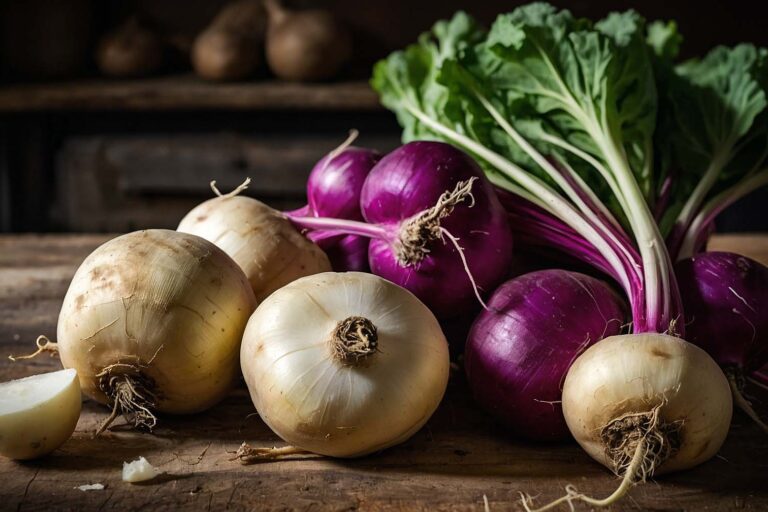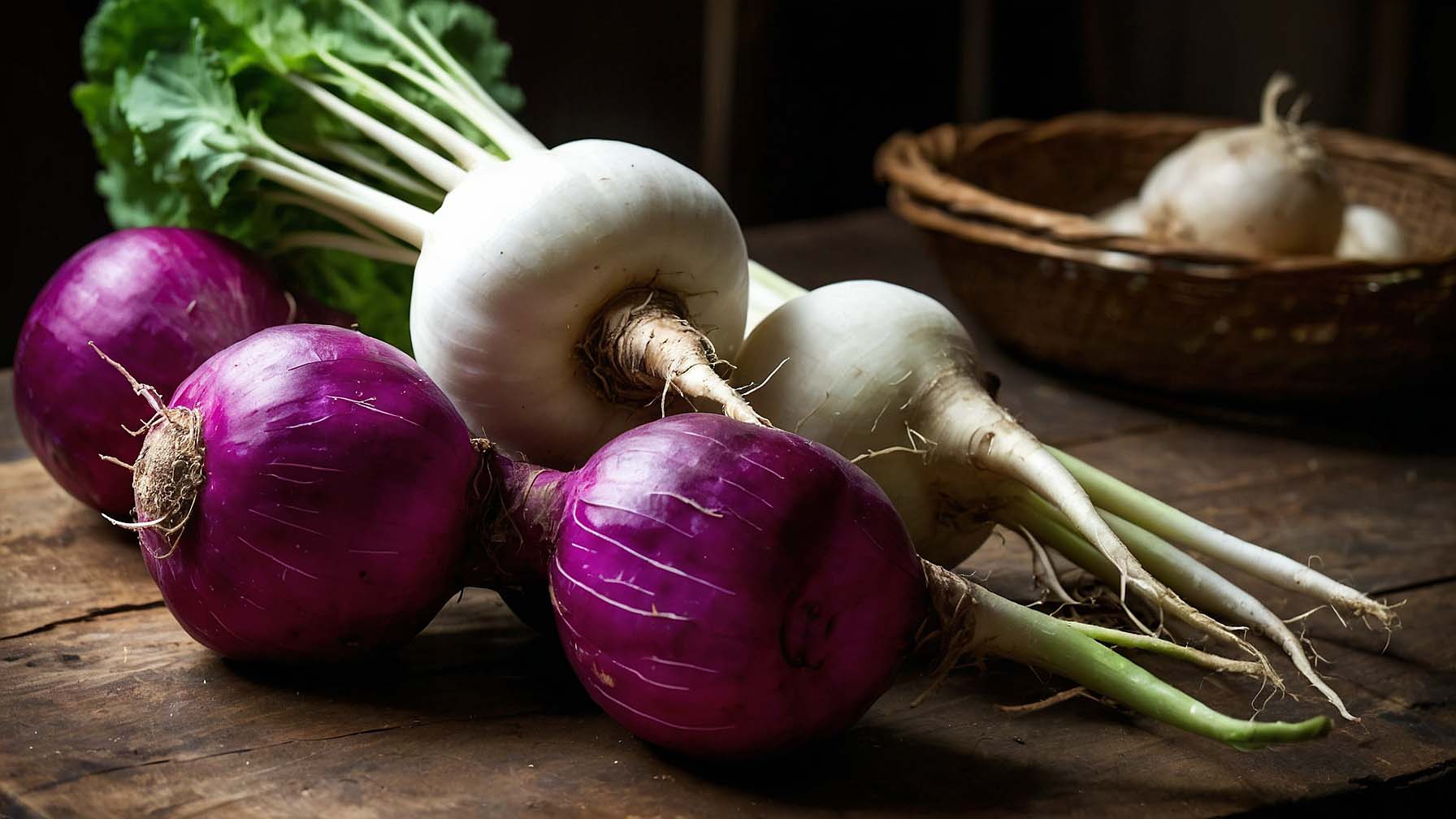Yes, you can eat turnips raw. They are crunchy and slightly peppery, similar to radishes.
Turnips, often overlooked yet versatile root vegetables, pack a punch when it comes to nutrition and culinary flexibility. Raw turnips provide an excellent crunch and a spicy kick that can enhance salads, slaws, or veggie platters. Being rich in vitamins, minerals, and fiber, they make a healthy addition to any diet.
The Nutritional Profile of Raw Turnips

Exploring the nutritional profile of raw turnips unfolds a treasure of health benefits. This crunchy veggie, often overlooked, is more than just a root to stew. Eaten raw, turnips pack a punch of nutrients ideal for maintaining a healthy lifestyle. Let’s delve into what makes raw turnips a smart choice for health-conscious eaters.
Vitamin and Mineral Content
Raw turnips are a powerhouse of vitamins and minerals. They are particularly rich in Vitamin C, which acts as an antioxidant and supports the immune system. A single serving of raw turnips can provide a significant boost to your daily vitamin intake. Here’s a quick look at some key vitamins and minerals found in raw turnips:
- Vitamin C: Enhances immunity and skin health
- Folate: Essential for DNA synthesis and repair
- Calcium: Vital for bone health
- Potassium: Helps regulate fluid balance
- Magnesium: Supports muscle and nerve function
Fiber and Digestive Health Benefits
Including raw turnips in your diet means tapping into their fiber-rich profile. Fiber is crucial for digestive health, and turnips deliver this nutrient efficiently. The fiber present in raw turnips not only helps with regular bowel movements but also contributes to feeling full, aiding in weight management.
| Nutrient | Benefit |
|---|---|
| Dietary Fiber | Improves digestion, reduces hunger |
| Prebiotics | Nourishes gut bacteria, enhances gut health |
These fibrous roots are not only tasty but also promote a happy gut. Eating turnips raw ensures that the intricate fibers remain intact, providing maximum benefits. Regular consumption can lead to improved digestion and overall wellness.
Culinary Uses of Raw Turnips
The Culinary Uses of Raw Turnips might surprise you. These root vegetables, crisp and mildly spicy, make a refreshing addition to many dishes. Packed with nutrients and a peppery flavor similar to radishes, raw turnips can transform a meal. Let’s explore how you can incorporate these crunchy delights into your diet.
Salads and Slaws Incorporation
Raw turnips shine brightly in salads and slaws. They add a crunchy texture that pairs well with a variety of dressings. Try these ideas:
- Grate turnips into your coleslaw mix for an extra zing.
- Cube them and add to a garden salad for a satisfying crunch.
- Thinly slice and layer with apples for a fresh lunch option.
Combine these with lemon juice, olive oil, salt, and pepper to create a simple yet delicious dressing.
Creative Snacking Options
Behold the versatility of raw turnips in snacking:
- Sticks: Cut into sticks and dip into your favorite hummus or yogurt dip.
- Chips: Slice thinly, sprinkle with sea salt, and serve for a crunchy treat.
- Quick pickles: Pickle thin slices for a tangy, healthy snack.
These snacking options are not only tasty but also healthy. They offer a low-calorie, fiber-rich alternative to traditional snacks. So next time you reach for a snack, consider the humble turnip.
Safety Considerations for Consuming Raw Turnips
Eating raw turnips can be a crunchy and nutritious addition to your diet. Before diving into this refreshing snack, it’s crucial to consider safety to ensure a healthy experience. This section delves into crucial aspects to consider for safe consumption.
Possible Allergies and Intolerances
Food sensitivities can affect your health. Some individuals may have an allergy or intolerance to turnips. Common signs include itching, hives, or stomach issues after eating turnips. Consult a doctor before adding them to your diet.
Hygiene and Foodborne Illness Prevention
To reduce risks, practice proper hygiene. Always wash turnips thoroughly before eating. Use these steps:
- Rinse under cold running water
- Scrub with a clean vegetable brush
- Pat dry with a paper towel
Eating unwashed turnips can lead to illness. Foodborne bacteria or pesticides remain on unwashed produce. Always prepare turnips safely to enjoy their full health benefits.
Taste and Texture Experience
Many people wonder about the crunch and zing of raw turnips. This root vegetable may not be as popular as its cousins, like carrots or potatoes, but it holds a treasure of flavors and textures. Raw, they offer a sharp, tangy taste with a satisfyingly crisp bite. Delving into the taste and texture experience of turnips uncovers a uniquely fresh culinary adventure.
Flavor Profile of Raw Vs. Cooked Turnips
Raw turnips boast a crisp, peppery flavor reminiscent of radishes. They yield a surprising spiciness that can add an invigorating twist to salads and slaws. Contrarily, cooked turnips reveal a milder essence. The heat softens their boldness, bringing out a sweet nuttiness akin to roasted garlic. The texture also transforms from solid and crunchy to tender and velvety.
| Turnip State | Flavor | Texture |
|---|---|---|
| Raw | Peppery and spicy | Crisp and crunchy |
| Cooked | Sweet and nutty | Tender and soft |
Pairing Raw Turnips With Other Ingredients
An exciting aspect of raw turnips is their versatility in pairing with other ingredients. Their sharpness cuts through the richness of creamy cheeses and the crunch contrast beautifully with soft grains. Here are some pairings:
- Salads: Shred raw turnips and mix with leafy greens, apples, and nuts for a fresh salad.
- Dips: Use thin slices as a low-carb dipper with hummus or Greek yogurt dips.
- Quick Pickles: Marinate in vinegar for a tangy condiment to sandwiches or tacos.
Experimenting with raw turnips can lead to delightful discoveries. They adapt remarkably to various flavor profiles and textures, enhancing dishes with their unique characteristics.
Learn more: Do You Peel Turnips Before Cooking
Selecting and Preparing Turnips for Raw Consumption
Have you ever considered the crisp, peppery delight of a raw turnip? Unlike their root vegetable cousins that often require cooking, turnips offer a burst of flavor and nutrition without the need for heat. Selecting and preparing turnips for raw consumption is simple. Discover the steps to enjoy turnips in their most natural and crunchy form!
Choosing the Best Turnips
The key to enjoying raw turnips starts with selecting the right ones. Look for small to medium-sized turnips with smooth, unblemished skin. Their color should be a vibrant mix of white and purple with healthy-looking greens still attached if possible. Freshness is imperative, so aim for turnips that are firm to the touch and feel heavy for their size.
Preparing and Storing for Optimal Freshness
Once you’ve selected the best turnips, proper preparation and storage ensure they stay crisp and tasty. Begin by washing the turnips in cool water, scrubbing away any dirt. Pat them dry to prevent any potential rot caused by excess moisture.
To store, trim the greens and place the turnips in a plastic bag with a paper towel to absorb moisture. Keep them in the crisper drawer of your refrigerator. This method maintains their freshness for a week or more, leaving you with a crunchy, nutritious snack always on hand.
For consumption, peel the turnips if desired, though it’s not necessary since their skin is edible. Slice, dice, or shred the raw turnips to use in salads, slaws, or simply to enjoy as a stand-alone snack with a sprinkle of salt. Store any cut pieces in an airtight container in the fridge to maintain their crispness.
Conclusion
Eating turnips raw is not only safe but also nutritious. They can add a crisp, refreshing bite to your salads and snacks. Rich in vitamins and minerals, raw turnips cater to a well-rounded diet. Don’t hesitate to slice, dice, or shred them into your next healthy meal creation. See all in at Farm Pioneer for knowledge based for Turnips.
